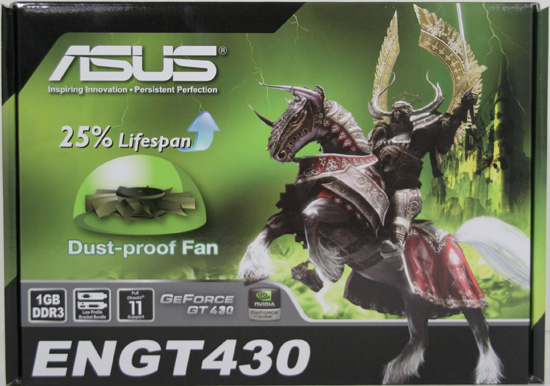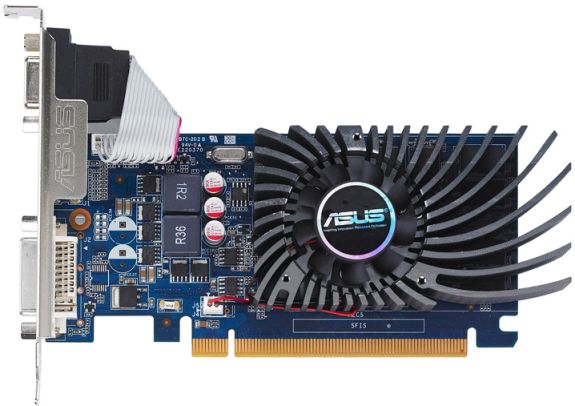NVIDIA's GeForce GT 430: The Next HTPC King?
by Ryan Smith & Ganesh T S on October 11, 2010 9:00 AM ESTMeet the Asus ENGT430
For our look today at the GT 430, Asus graciously provided us with their GT 430 card, the ENGT430. As with all the other cards being released it’s a custom design, featuring the usual Asus design elements: a double-sealed fan, fuse protection, and - while we have a hard time believing this is an issue on such a small card – GPU guard PCB reinforcement.
For this card Asus is very specifically going after the HTPC market. The ENGT430 is a half-height card with a low-profile bracket included, and for cooling it uses a decently sized heatsink with a particularly tiny fan we measure at 36mm. The heatsink does stick up some, so the card is explicitly a double-slot card and you’ll want to make sure you have space for it.
As is the case with low-end cards, reference clocks don’t tend to mean much. While the GT 430 has a reference speed of 700MHz for the core and 1.8GHz effective for the DDR3 memory, Asus has gone ahead and clocked the card at 1.6GHz for the memory. The card is equipped with 8 800MHz (1.6GHz effective) Hynix DDR3 memory modules running in 16bit mode, which is why the card is clocked below NVIDIA’s reference clocks. We expect to see memory clocks all over the place with the launch cards, depending particularly on who could get the best deal on what speed grade of DDR3 RAM for these cards. Given that GT 430 is likely already a memory bandwidth challenged card, this will have an impact, although we don’t have the means to measure it (our card would only go to 1.75GHz on the RAM).

For ports Asus is going with what’s undoubtedly going to be the universal configuration for low-profile GT430 cards: 1x DVI, 1x HDMI, and 1 VGA port. The DVI port is necessary for monitors (without resorting to a dongle), the HDMI port is necessary for HTPC roles, and the VGA port being an easy addition as an optional 3rd port due to its analog nature. GF108 can only drive 2 monitors at once, so the usual restrictions apply.
As is common for budget cards, there’s little else besides the card in the box. Asus includes the low-profile bracket, a multilingual quick installation guide, and a driver CD. This is the first Asus card we’ve reviewed for some time without voltage tweaking capabilities, so even NVIDIA’s integrated overclocking utility is enough for the task.












120 Comments
View All Comments
duploxxx - Friday, October 15, 2010 - link
makes you wonder how good your IT qualities are.... had tons of ati and nvidia cards, never had issues with ati or nvidia. Sure both of them have had a few glitches but that is more due to MS and the drivers.btw it's often due to crappy OEM implementation of the vendor driver, ever thought of that????
dnd728 - Friday, October 15, 2010 - link
Another Einstein...Fallen Kell - Tuesday, October 12, 2010 - link
I bought a passive AMD 5750 which I use in my HTPC, mainly to gain Blu-Ray audio bitstreaming. I have to say, AMD still has a lot of work they need to do in terms of their drivers. As much as I love the capabilities of this card, I spent 5 days getting it to work properly and output the bitstreamed audio. I think that is probably a large reason why their market share hasn't grown. It should have just worked after I installed the latest drivers. But no, I had to download a specific version (not the latest), had to also download audio drivers from ANOTHER company entirely (not AMD), get a specific version of those drivers (not the latest), install them in the proper order (i.e. install the third party drivers after I installed AMD's drivers).... It was hoop after hoop after hoop.... A normal consumer would have simply taken the card back as "broken".khimera2000 - Thursday, October 14, 2010 - link
I had to change the default audio after the ATI drivers installed... it took me two minuts to get it working ;Dtherealnickdanger - Monday, October 11, 2010 - link
If image quality is so important, you wouldn't watch anything but 1080p24 Blu-Ray in the first place! :)But seriously, in the days of DVD, HQV tests were of higher importance because DVD was 480i, when the movies and television shows were typically sourced on film @ 24 fps. With Blu-Ray, you get to watch TV and film in the native cadence with no deinterlacing, and you certainly don't want resoution scaling or conversion of any kind. Any attempt to artificially smooth or sharpen the image would adversely affect image quality.
The most important feature to home theater enthusiasts is the purest representation of the original source, without enchancements or filters.
ganeshts - Monday, October 11, 2010 - link
I am sure there are plenty of HTPC users who shoot using camcorders like the Flip or the Playsport. Not all of those videos are in 60fps. 30 fps videos need to be 2:2 pulled-down. Cadence detection helps a lot here.In addition, Blu-Ray also allows 1080i videos. Of course, if you have a video processor, source direct is best. However, a good HTPC is supposed to make a video processor redundant.
We have mentioned in the review that power users can always work around the unimplemented features by doing a 'source direct' playback.
Stonedofmoo - Monday, October 11, 2010 - link
For me the only reason I was holding out for this card was to see how effective it would be as a dedicated PhysX card to use in conjunction with my GTX460 1Gb.The GTS450 seems rather overkill for just that task so I was hoping the GT430 would be the ideal cheap option..
Ryan Smith - Monday, October 11, 2010 - link
To be honest it's not something I had a chance to test. I've only had the card since Friday afternoon, so there wasn't much room for extras. I'll see if I can squeeze it in today.Stonedofmoo - Monday, October 11, 2010 - link
No worries, it would be interesting to see if it's any use for a dedicated PhysX card.Thanks for the review :-)
Snoopy_69__ - Monday, October 11, 2010 - link
Unless someone makes a fanless GT430